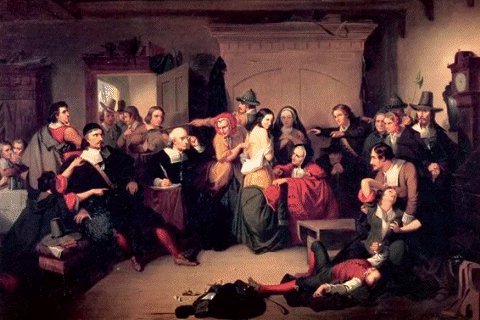Reverend Samuel Parris was a minister around the time of this crisis. He was not very popular among the Puritan villagers. In 1692, Reverend Parris' daughter and niece, who were nine and eleven years old, along with Ann Putnam who was also eleven, began to act in a strange manner. The girls were seen screaming, throwing things, making odd noises, and bending themselves into odd positions. The people of Salem suspected the girls were a victim of witchcraft (http://kids.nationalgeographic.com/kids/stories/history/salem-witch-trials/).
Jonathan Corwin and John Hathorne pressured the girls into surrendering the names of the people who were to blame for their behavior. The girl's blamed Reverend Parris' Caribbean slave, a homeless woman, and an elderly woman. Tituba, the slave, was the only woman to confess. She claimed Satan came to her and asked her to serve him along with several other witches with a purpose to destroy the Puritans. The three women were put in jail and this sparked a new level of fear in Salem (http://www.eyewitnesstohistory.com/salem.htm).
 Governor William Phipps set up the Special Court of Oyer and Terminer. This court was established to hear the cases of the women who were accused of being witches and determine their fate. Martha Corey was soon accused by the three girls of being a witch. Corey was a thought of as being very dedicated to the Church of Salem Village. The community began to lose trust with each other and assumed anyone could be a witch (http://www.smithsonianmag.com/history-archaeology/brief-salem.html?c=y&page=1). Eventually, the accusations ended and so did the Special Court. There were nineteen people hung, a seventy-one year old man was smashed with a heavy stone, and at least four died in prison (http://www.eyewitnesstohistory.com/salem.htm).
Governor William Phipps set up the Special Court of Oyer and Terminer. This court was established to hear the cases of the women who were accused of being witches and determine their fate. Martha Corey was soon accused by the three girls of being a witch. Corey was a thought of as being very dedicated to the Church of Salem Village. The community began to lose trust with each other and assumed anyone could be a witch (http://www.smithsonianmag.com/history-archaeology/brief-salem.html?c=y&page=1). Eventually, the accusations ended and so did the Special Court. There were nineteen people hung, a seventy-one year old man was smashed with a heavy stone, and at least four died in prison (http://www.eyewitnesstohistory.com/salem.htm).  In 1976, studies were done to determine a possible cause for the strange behavior in the children. There is a fungus that is found on wheat and rye that causes muscle spasms, vomiting, delusions and hallucinations. The fungus is found in climates much like Salem and with rye as a major part of their diet, there is a very high possibility the fungus caused the behavior (http://www.smithsonianmag.com/history-archaeology/brief-salem.html?c=y&page=2).
In 1976, studies were done to determine a possible cause for the strange behavior in the children. There is a fungus that is found on wheat and rye that causes muscle spasms, vomiting, delusions and hallucinations. The fungus is found in climates much like Salem and with rye as a major part of their diet, there is a very high possibility the fungus caused the behavior (http://www.smithsonianmag.com/history-archaeology/brief-salem.html?c=y&page=2).
The Puritan's extreme beliefs can be blamed for the irrational judgement of others. If a person did not act in a manner that would be pleasing to God, the Puritans believed it was an act of Satan. The Salem community was not afraid of anything more than the devil because of the fear that the Puritan ministers emphasized. There were twenty-four innocent people that died and over two-hundred that had their reputations ruined because they were accused of practicing the work of Satan (http://www.smithsonianmag.com/history-archaeology/brief-salem.html?c=y&page=2).
Supplemental Video: http://school.discoveryeducation.com/schooladventures/salemwitchtrials/story/story.html

